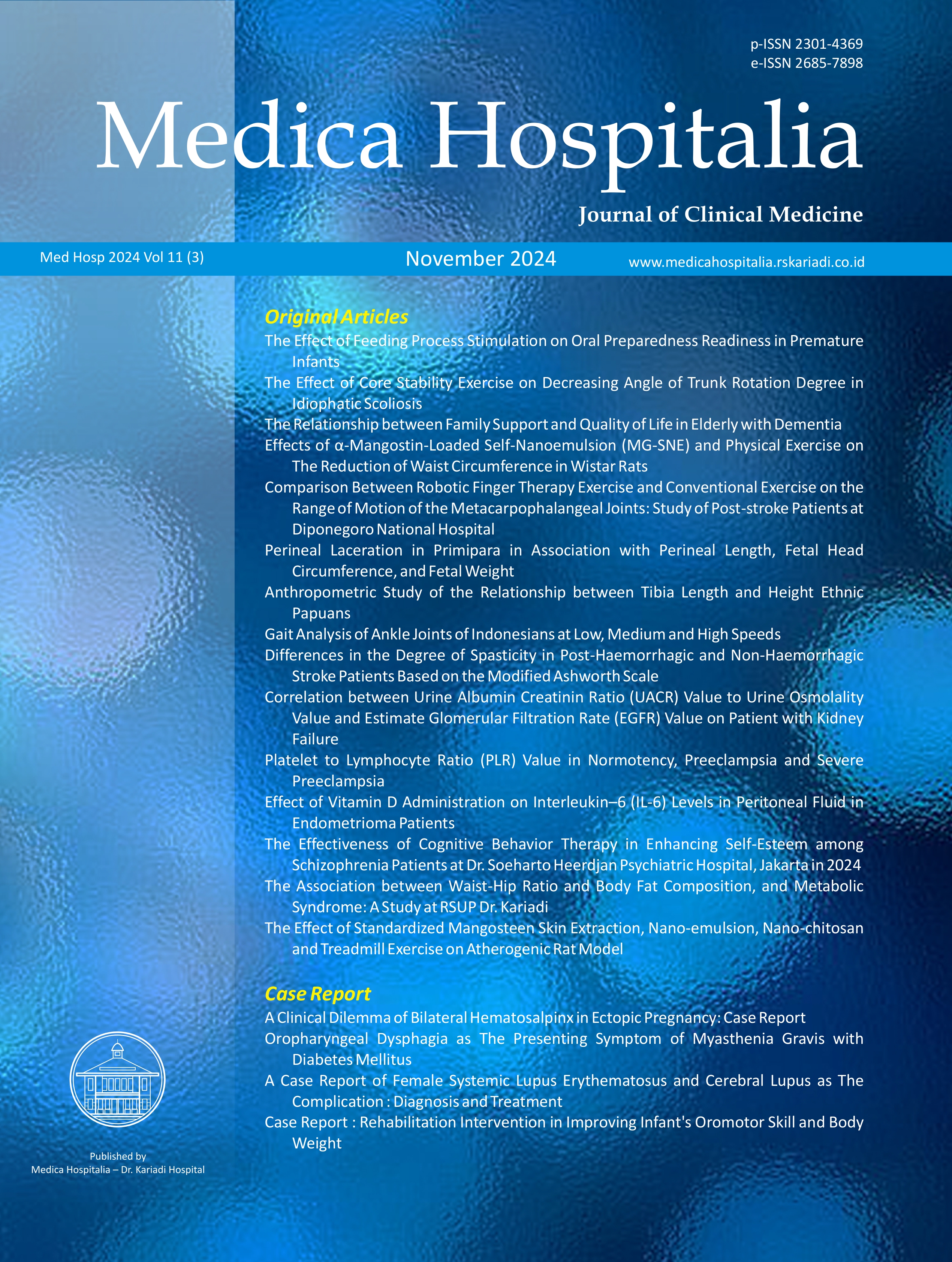Evaluation of Definitive Antibiotic Therapy Effectiveness in Sepsis Patients at Tabanan Hospital, Indonesia
DOI:
https://doi.org/10.36408/mhjcm.v12i1.1210Keywords:
antimicrobial stewardship, clinical outcomes, definitive antibiotics, empiric antibiotics, sepsisAbstract
BACKGROUND : The study evaluated the use of definitive antibiotics and examined the association between the causative bacteria, resistance patterns, and antibiotic regimens with clinical outcomes in sepsis.
AIMS : To assess the suitability of definitive antibiotics in sepsis patients at Tabanan Hospital, focusing on the correlation between bacterial type, antibiotics, and resistance profiles with clinical outcomes, aiming to improve sepsis management and reduce antibiotic resistance.
METHOD : The observational cross-sectional study analyzed data descriptively to evaluate antibiotic-pathogen compatibility retrospectively. Chi-square tests were used for bivariate analysis of mortality-related variables. Survival analysis employed the Kaplan-Meier method.
RESULT : Among 112 sepsis patient records (Jan 2020 - Dec 2022), 62% received antibiotics based on bacterial sensitivity test contradiction to another 38% who were given inappropriately antibiotic. Empiric antibiotic treatment was associated with increased mortality (OR=4.379; CI 95% 1.274-15.052; P=0.022). Bacterial type and resistance status showed no significant association with mortality (OR=0.417; CI 95% 0.030-5.708; P=1.000 and OR=1.500; CI 95% 0.156-14.420; P=1.000, respectively).
CONCLUSION : Definitive antibiotic use for sepsis patients at Tabanan Hospital was mostly appropriate, and the empiric antibiotics treatment was associated with mortality, while the causal bacteria and resistance status were not significantly associated with mortality. Findings highlight the importance of transitioning from empiric to targeted therapy to potentially reduce mortality in sepsis management.
Downloads
References
1. M. Singer, C. S. Deutschman, C. W. Seymour, M. Shankar-Hari, D. Annane, M. Bauer, et al. 2016. "The Third International Consensus Definitions for Sepsis and Septic Shock (Sepsis-3)." JAMA 315(8):801-810. Retrieved (https://doi.org/10.1001/jama.2016.0287).
2. K. Grozdanovski, Z. Milenkovikj, H. Demiri, K. Spasovska, M. Cvetanovska, V. Saveski, et al. 2018. "Epidemiology of Community-Acquired Sepsis in Adult Patients: A Six Year Observational Study." Sciendo 39:59-66. Retrieved (https://doi.org/10.2478/prilozi-2018-0024).
3. K. E. Rudd, N. Kissoon, D. Limmathurotsakul, S. Bory, B. Mutahunga, C. W. Seymour, et al. 2018. "The Global Burden of Sepsis: Barriers and Potential Solutions." Crit Care 22(1):232. Retrieved (https://doi.org/10.1186/s13054-018-2157-z).
4. M. Batara, S. Darmawati, M. E. Prastiyanto. 2018. "Keanekaragaman dan Pola Resistensi Bakteri pada Pasien yang Terdiagnosa Sepsis." Journal Labora Medika 2:1-5. Retrieved (https://doi.org/10.26714/jlabmed.2.2.2018.1-5).
5. L. Evans, A. Rhodes, W. Alhazzani, M. Antonelli, C. M. Coopersmith, C. French, et al. 2021. "Surviving Sepsis Campaign: International Guidelines for Management of Sepsis and Septic Shock." Intensive Care Med 47:1181-1247. Retrieved (https://doi.org/10.1097/CCM.0000000000005337).
6. M. L. Martínez, E. P. Plata-Menchaca, J. C. Ruiz-Rodríguez, R. Ferrer. 2020. "An Approach to Antibiotic Treatment in Patients with Sepsis." Journal Thorac Dis 12(3):1007-1021. Retrieved (https://doi.org/10.21037/jtd.2020.01.47).
7. M. H. Legese, D. Asrat, G. Swedberg, B. Hasan, A. Mekasha, T. Getahun, et al. 2022. "Sepsis: Emerging Pathogens and Antimicrobial Resistance in Ethiopian Referral Hospitals." Antimicrob Resist Infect Control 11(83):1-16. Retrieved (https://doi.org/10.1186/s13756-022-01122-x).
8. I. S. Pradipta, D. C. Sodik, K. Lestari, I. Parwati, E. Halimah, A. Diantini, et al. 2013. "Antibiotic Resistance in Sepsis Patients: Evaluation and Recommendation of Antibiotic Use." North Am J Med Sci 5(6):344-352. Retrieved (https://doi.org/10.4103/1947-2714.114165).
9. N. M. A. Agustini, D. K. Wati, I. B. G. Suparyatha, I. N. B. Hartawan, I. M. G. D. L. Utama, N. N. S. Budayanti, et al. 2018. "The Relationship Between Bacterial Types and Antibiotic Resistance with The Clinical Outcomes of Sepsis Patients in Pediatric Intensive Care Unit at Sanglah Hospital Denpasar, Bali-Indonesia." Indones J Biomed Sci 12(1):13-18. Retrieved (https://doi.org/10.15562/ijbs.v12i1.144).
10. M. S. Niederman, R. M. Baron, L. Bouadma, et al. 2021. "Initial Antimicrobial Management of Sepsis." Crit Care 25:307. Retrieved (https://doi.org/10.1186/s13054-021-03736-w).
11. E. Ekayana, A. Fithrie, I. K. Nasution. 2019. "Gambaran Bakteri dan Sensitivitas Antibiotik pada Pasien Stroke dengan Sepsis di Ruang Neurology RSUP Haji Adam Malik Medan." Neurona 36:106-112. Retrieved (https://doi.org/10.52386/neurona.v36i2.62).
12. Sugiyono, Padmasari. 2019. "Hubungan Kesesuaian Antibiotik Definitif dengan Clinical Outcome pada Pasien Ulkus Diabetik di RSUD Kota Yogyakarta." Fitofarmaka 9(1):56-63. Retrieved (https://doi.org/10.33751/jf.v9i1.1261).
13. I. D. Toyyibah, M. Rusli, Juniastuti. 2022. "Bacterial Pattern among Sepsis Patients in Internal Medicine Inpatient Ward Dr. Soetomo General Academic Hospital, Surabaya, Indonesia." Majalah Biomorfologi 32(2):52-58. Retrieved (https://doi.org/10.20473/mbiom.v32i2.2022.52-58).
14. A. Y. Nugraheni, M. S. Putri, A. Y. Saputro. 2021. "Evaluasi Ketepatan Antibiotik pada Pasien Sepsis." Pharmacon: Jurnal Farmasi Indonesia 18(2):194-207. Retrieved (https://doi.org/10.23917/pharmacon.v18i2.16635).
15. L. Gay, C. Melenotte, I. Lakbar, S. Mezouar, C. Devaux, D. Raoult, et al. 2021. "Sexual Dimorphism and Gender in Infectious Diseases." Front Immunol 12:698121. Retrieved (https://doi.org/10.3389/fimmu.2021.698121).
16. E. Quiros-Roldan, A. Sottini, P. G. Natali, L. Imberti. 2024. "The Impact of Immune System Aging on Infectious Diseases." Microorganisms 12:775. Retrieved (https://doi.org/10.3390/microorganisms12040775).
17. Y. Jiang, F. Q. Jiang, P. Kong, M. An, B. Jin, D. Cao, et al. 2019. "Inflammatory Anemia-Associated Parameters are Related to 28-Day Mortality in Patients with Sepsis Admitted to The ICU: A Preliminary Observational Study." Ann Intensive Care 9:1-11. Retrieved (https://doi.org/10.1186/s13613-019-0542-7).
18. F. B. Mayr, S. Yende, D. C. Angus. 2014. "Epidemiology of Severe Sepsis." Virulence 5:4–11. Retrieved (https://doi.org/10.4161/viru.27372).
19. W. Siswandari, R. A. N. Hestiyani, V. Indriani, I. D. S. A. P. Peramiarti. 2018. "Profil Bakteri Penyebab Sepsis di Ruang Perawatan Intensive RSUD Prof Dr. Margono Soekarjo Purwokerto." Prosiding Seminar Nasional dan Call for Papers 14:340-347. Available at: http://jurnal.lppm.unsoed.ac.id/ojs/index.php/Prosiding/article/view/828. Date accessed: 9 Jan. 2024.
20. F.N. Maliza, A. P. Gonibala. 2023. "Pola Penggunaan Antibiotik Pada Pasien Sepsis Rawat Inap di RSUD Dr. MOEWARDI." J Pharm Sci Med Res 6(1):11-20. Retrieved (https://doi.org/10.25273/pharmed.v6i1.15759).
21. Y. Sun, Y. Liu, J. Wang, C. Cui. 2023. "The Effect of Meropenem versus Piperacillin-Tazobactam in Critically Ill Patients with Sepsis and Septic Shock." Heliyon 9(6). Retrieved (https://doi.org/10.1016/j.heliyon.2023.e16542).
22. Safitri, Y., Rohmi, Gede, LS. 2017. “Identifikasi Jenis Sampel (Bakteri Murni dan Campuran Bakteri) Penyebab ISK terhadap Hasil Uji Sensitivity Antibiotik Ciprofloxacin”. Jurnal Analis Medika Bio Sain 4(1):12–16. Retrieved (https://doi.org/10.32807/jambs.v4i1.78).
23. Ramita, GR, Gama, SI, Ramadhan, AM. 2018. “Hubungan Ketepatan Pemilihan Antibiotik Empiris dengan Outcome Terapi pada Pasien Sepsis di Instalasi Rawat Inap Beberapa Rumah Sakit”. Proceeding of the 8th Mulawarman Pharmaceuticals Conferences, Samarinda, November 2018 220–228. Retrieved (https://doi.org/10.25026/mpc.v8i1.327).
24. M. Sijbom, K. K. Braun, F. L. Buchner, L. B. Vos, B. J. C. Hendriks, M. G. J. Boer, et al. 2022. "Cues to Improve Antibiotic-Allergy Registration: A Mixed-Method Study." PLoS One 17(4):1-13. Retrieved (https://doi.org/10.1371/journal.pone.0266473).
25. M. P. Morgan, T. Szakmany, S. G. Power, P. Olaniyi, J. E. Hall, K. Rowan, et al. 2016. "Sepsis Patients with First and Second-Hit Infections Show Different Outcomes Depending on the Causative Organism." Front Microbiol 7:1-7. Retrieved (https://doi.org/10.3389/fmicb.2016.00207).
26. Q. Guo, P. Qu, W. Cui, M. Liu, H. Zhu, W. Chen, et al. 2023. "Organism Type of Infection is Associated with Prognosis in Sepsis: An Analysis from The Mimic-IV Database." BMC Infect Dis 23:1-11. Retrieved (https://doi.org/10.1186/s12879-023-08387-6).
27. Tang, A., Shi, Y., Dong, Q., Wang, S., Ge, Y., Wang, C., Gong, Z., Zhang, W., Chen, W. 2023. “Prognostic Differences in Sepsis Caused by Gram-Negative Bacteria and Gram-Positive Bacteria: A Systematic Review and Meta-Analysis”. Crit Care 27:1-12. Retrieved (https://doi.org/10.1186/s13054-023-04750-w).
28. Dyck, B., Unterberg, M., Adamzik, M., Koos, B. 2024. “The Impact of Pathogens on Sepsis Prevalence and Outcome”. Pathogens 13:1-10. Retrieved (https://doi.org/10.3390/ pathogens13010089).
29. S. Busani, G. Serafini, E. Mantovani, C. Venturelli, M. Giannella, P. Viale, et al. 2019. "Mortality in Patients With Septic Shock by Multidrug Resistant Bacteria: Risk Factors and Impact of Sepsis Treatments." J Intensive Care Med 34:48-54. Retrieved (https://doi.org/10.1177/0885066616688165).
30. N. Capsoni, P. Bellone, S. Aliberti, G. Sotgiu, D. Pavanello, B. Visintin, et al. 2019. "Prevalence, Risk Factors and Outcomes of Patients Coming from the Community with Sepsis Due to Multidrug-Resistant Bacteria." Multidiscip Respir Med 14:1-11. Retrieved (https://doi.org/10.1186/s40248-019-0185-4).
31. Ferrer R, Martin-Loeches, I., Phillips, G., Osborn, TM, Townsend, S., Dellinger, RP, Artigas, A., Schorr, C., Levy, MM. 2014. “Empiric Antibiotic Treatment Reduces Mortality in Severe Sepsis and Septic Shock from the First Hour: Results From a Guideline-based Performance Improvement Program”. Crit Care Med. 42(8):1749-55. Retrieved (10.1097/CCM.0000000000000330. PMID: 24717459).
32. J. Garnacho-Montero, A. Gutierrez, A. Escoresca, Y. Corcia, I. Herrera, C. Ortiz, et al. 2014. "De-escalation of Empirical Therapy is Associated with Lower Mortality in Patients with Severe Sepsis and Septic Shock." Intensive Care Med 40(1):32-40. Retrieved (https://doi.org/10.1007/s00134-013-3077-7).
Additional Files
Published
How to Cite
Issue
Section
Citation Check
License
Copyright (c) 2025 Luh Rai Maduretno Asvinigita, Ketut Tunas, Ida Ayu Alit Widhiartini, Agata Widatama, Rini Noviyani (Author)

This work is licensed under a Creative Commons Attribution-ShareAlike 4.0 International License.
Copyrights Notice
Copyrights:
Researchers publishing manuscrips at Medica Hospitalis: Journal of Clinical Medicine agree with regulations as follow:
Copyrights of each article belong to researchers, and it is likewise the patent rights
Researchers admit that Medica Hospitalia: Journal of Clinical Medicine has the right of first publication
Researchers may submit manuscripts separately, manage non exclusive distribution of published manuscripts into other versions (such as: being sent to researchers’ institutional repository, publication in the books, etc), admitting that manuscripts have been firstly published at Medica Hospitalia: Journal of Clinical Medicine
License:
Medica Hospitalia: Journal of Clinical Medicine is disseminated based on provisions of Creative Common Attribution-Share Alike 4.0 Internasional It allows individuals to duplicate and disseminate manuscripts in any formats, to alter, compose and make derivatives of manuscripts for any purpose. You are not allowed to use manuscripts for commercial purposes. You should properly acknowledge, reference links, and state that alterations have been made. You can do so in proper ways, but it does not hint that the licensors support you or your usage.
























